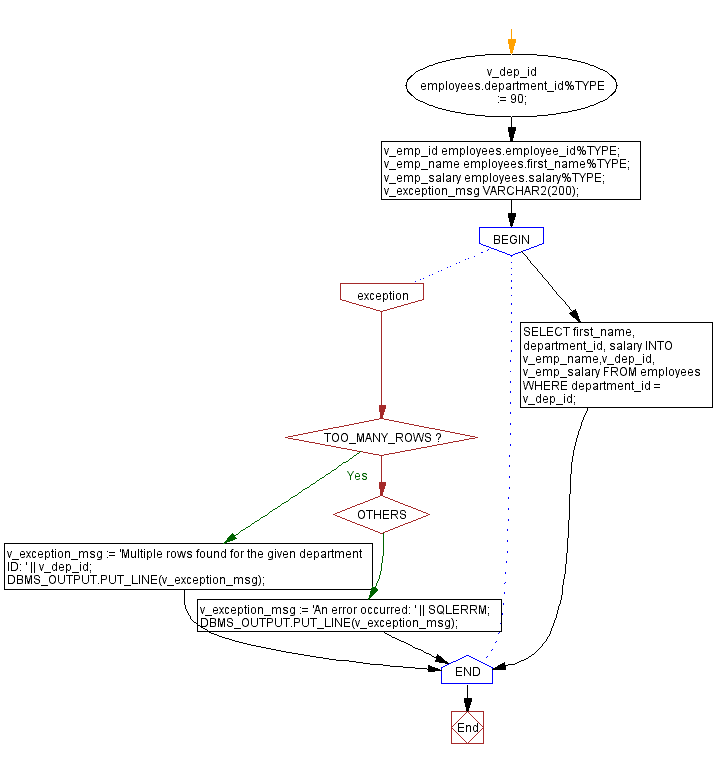Handling TOO_MANY_ROWS Exception in PL/SQL
PL/SQL Exception Handling: Exercise-3 with Solution
Handle the TOO_MANY_ROWS exception when retrieving multiple rows instead of a single row from a table.
Sample Solution:
Table: employees
employee_id integer first_name varchar(25) last_name varchar(25) email archar(25) phone_number varchar(15) hire_date date job_id varchar(25) salary integer commission_pct decimal(5,2) manager_id integer department_id integer
PL/SQL Code:
DECLARE
v_dep_id employees.department_id%TYPE := 90;
v_emp_id employees.employee_id%TYPE;
v_emp_name employees.first_name%TYPE;
v_emp_salary employees.salary%TYPE;
v_exception_msg VARCHAR2(200);
BEGIN
SELECT first_name, department_id, salary
INTO v_emp_name,v_dep_id, v_emp_salary
FROM employees
WHERE department_id = v_dep_id;
EXCEPTION
WHEN TOO_MANY_ROWS THEN
v_exception_msg := 'Multiple rows found for the given department ID: ' || v_dep_id;
DBMS_OUTPUT.PUT_LINE(v_exception_msg);
WHEN OTHERS THEN
v_exception_msg := 'An error occurred: ' || SQLERRM;
DBMS_OUTPUT.PUT_LINE(v_exception_msg);
END;
Sample Output:
multiple rows found for the given department ID: 90
Explanation:
The said code in Oracle's PL/SQL demonstrates the handling of the TOO_MANY_ROWS exception when retrieving multiple rows based on the department_id from the 'employees' table.
The variable v_dep_id is assigned by the department ID value 90.
The SELECT INTO statement retrieves the first_name, department_id, and salary from the employees table based on the specified department_id value.
The query returns multiple rows, and the TOO_MANY_ROWS exception is raised, and the corresponding exception block is triggered and the variable v_exception_msg is assigned an error message indicating that multiple rows were found for the given department ID. This message is then displays using DBMS_OUTPUT.PUT_LINE.
The OTHERS exception block is used to handle any other exceptions that may occur during the execution of the code. This message is also printed using DBMS_OUTPUT.PUT_LINE.
Flowchart:

Go to:
PREV : Handling NO_DATA_FOUND exception in PL/SQL.
NEXT : Handling invalid number exception in PL/SQL.
Have another way to solve this solution? Contribute your code (and comments) through Disqus.
What is the difficulty level of this exercise?
